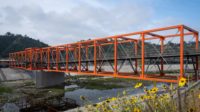An Unexpected Building Boom in L.A.
The nine-college Los Angeles Community College District is in a unique situation. Despite a nationwide economic slump that is one of the worst in 50 years, the district has money to spend—and to build.
LACCD, which serves more than 220,000 students throughout Los Angeles County, is in the middle of a $5.7-billion building program, funded by three bonds passed in the last eight years. The program, which began 2004 and is expected to be completed by 2014, is intended to modernize and add new facilities throughout the district.

The LACCD is working with numerous architectural firms, including Leo A Daly, Arquitectonica, WWCOT, and Harley Ellis Devereaux. Of the nearly 90 new buildings planned for the district, eight are completed, 29 are under construction, and 50 are either in the design phase or do not yet have an architect assigned to them.
The construction boom is being funded via a $1 billion bond passed in 2001, a $1.2 billion bond passed in 2003, and a $3.5 billion bond passed in November 2008. Larry Eisenberg, the district’s executive director of facilities planning and development, believes voters approved the largest ballot measure by more than 70 percent last fall—as the stock market was being battered and the economy was staggering—because they recognize the significance of education, especially during a recession. “I think people realize that community college is a pathway,” he says.
Certainly, the district isn’t wasting any time putting the money to use. Eisenberg estimates that they’re spending about $30 million a week in construction payments. He adds that the district has been able to capitalize on the low-bid environment and, in some cases, has been able to “get deeper” down its wish list because of it. For instance, at Pierce College, the cost saving have allowed the district to build a child development center at the campus that was not originally in the budget. “It’s helping us a lot. It’s an amazing market right now,” Eisenberg says.
One significant aspect of the program is that most of the buildings are designed to earn LEED certification. Two completed buildings have already achieved LEED Silver status and six are under review. The district has not set specific guidelines for LEED certification but has asked its designers to maximize sustainability wherever possible. “We try out a technology to see if it works or not,” Eisenberg says. “Pretty soon, we will have it down pat.”
The district is not the only one pleased to be building. General contractors, hungry for work, are finding that the LACCD is a good partner to have during the recession. Riverside-based J.D. Diffenbaugh is currently building three projects for the LACCD and describes the district as one of its best clients. “Even though they are a public agency, everything they do is open book,” says Valerie Leonard, who works in the contractor’s business development department. “There are no surprises.”
The Los Angeles office of Harley Ellis Devereaux is designing a learning resource center at the Los Angeles Trade-Technical College. The firm also is working on a design-build project with general contractor S.J. Amoroso; they recently won the bid for an 80,000-square-foot student union center at Los Angeles City College.
“LACCD is one of the clients that actually has money to go forward with projects,” says Brent Miller, AIA, principal at Harley Ellis Devereaux. “Overall, it’s a very well-managed program.” He also is impressed with its commitment to green building. “We’re very excited that the district has taken the lead to push a sustainable program and demand this from the architecture community,” he says. “We think it’s money well spent.”


